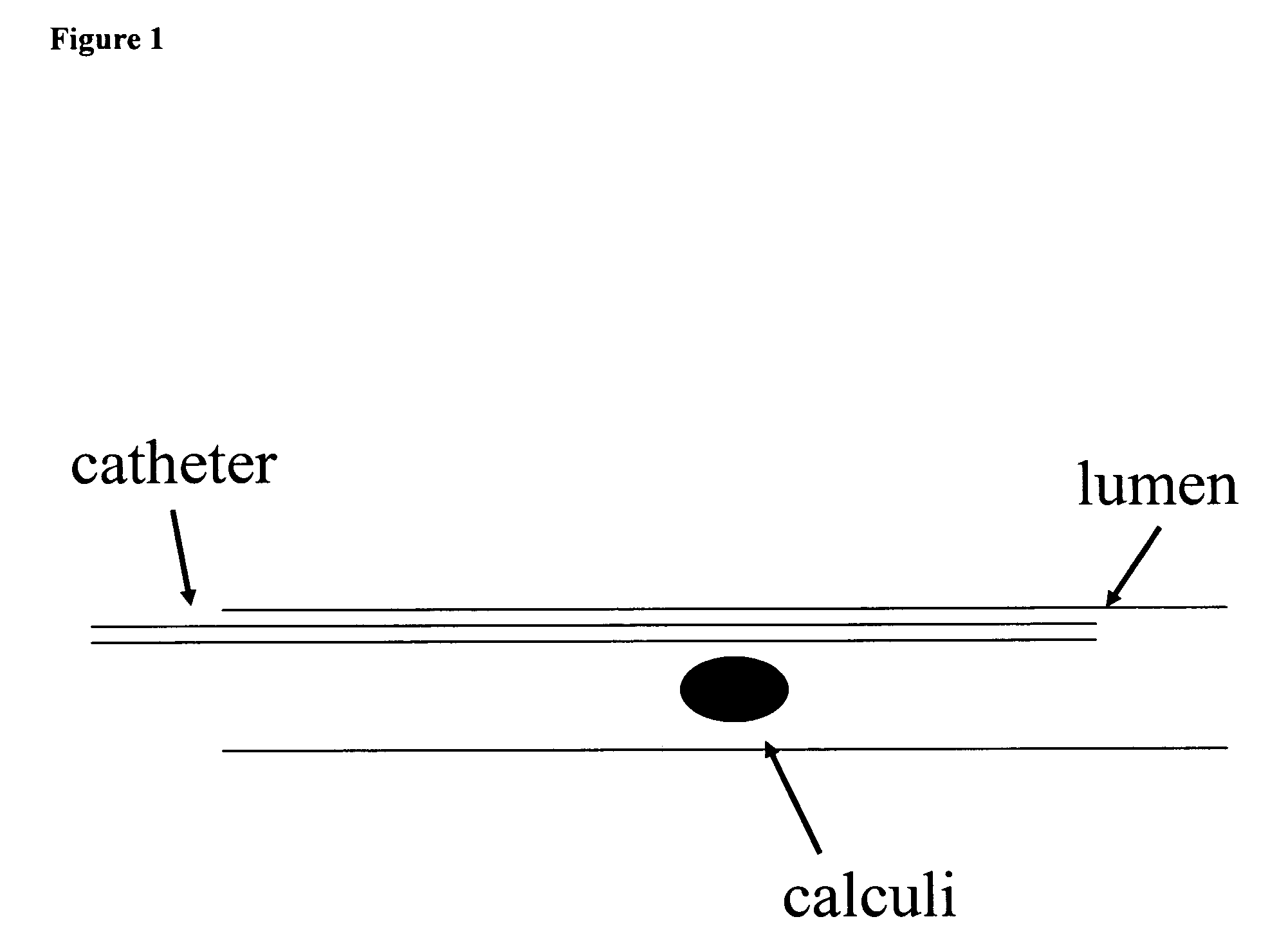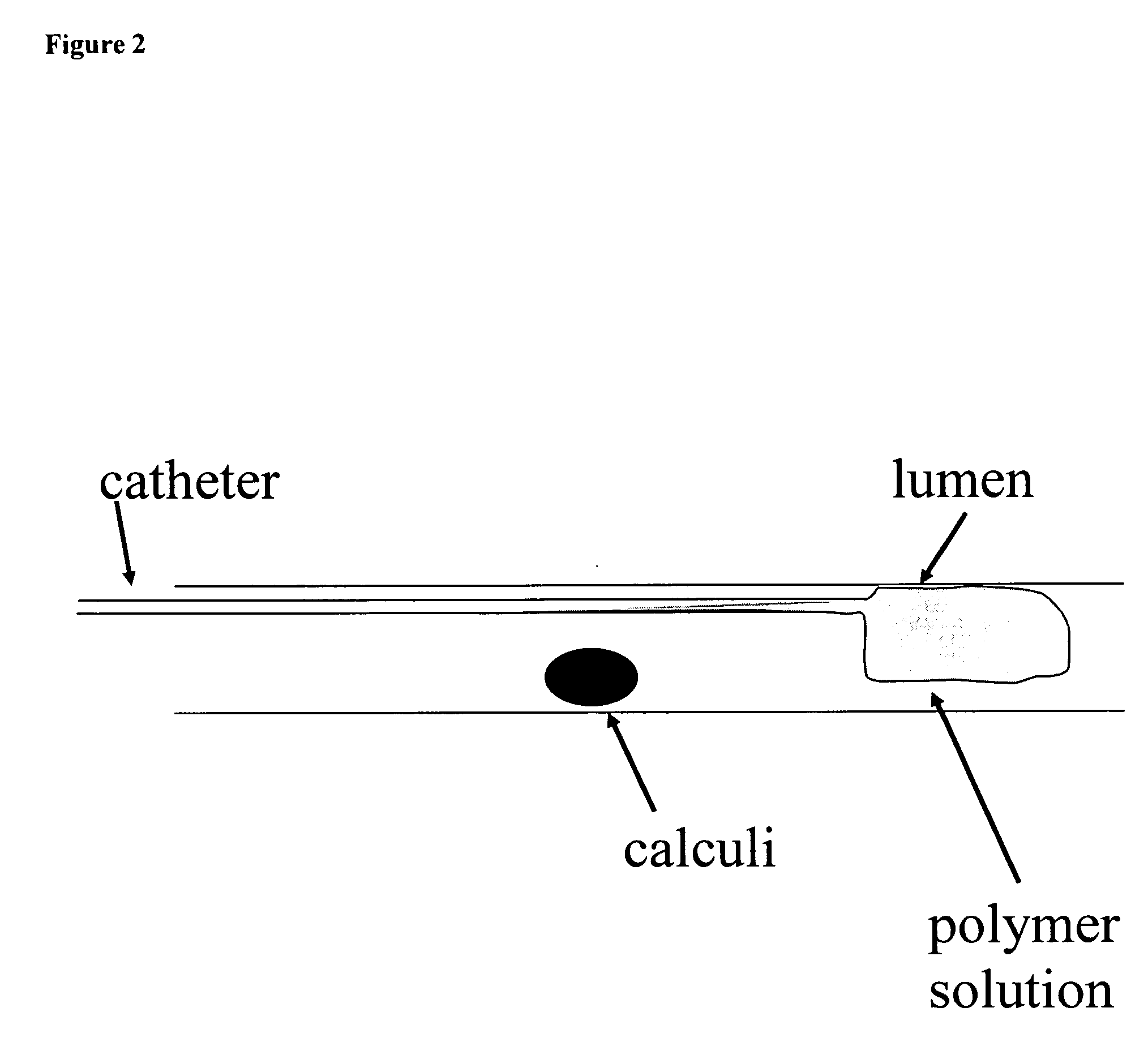Non-lithotripsic kidney-stone therapy
a kidneystone and non-lithotripsic technology, applied in the field of non-lithotripsic kidneystone therapy, can solve the problems of obstruction and pain, stone is typically an extremely hard and unyelding mass, and the passage of stones is typically painful and bleeding
- Summary
- Abstract
- Description
- Claims
- Application Information
AI Technical Summary
Benefits of technology
Problems solved by technology
Method used
Image
Examples
example 1
Gelation Temperature of Selected Pluronic® and Tetronic® Polymer Solutions
[0157] The polymer was weighed into a plastic tube. To achieve the required concentration the weight was multiplied by 4, for 25 weight percent (w %), and by 5, for 20 weight percent (w %), and the required final weight was achieved by adding saline. The solutions were placed in the fridge at 4° C. and usually were ready within 24 hours. Gelation points were measured in a Brookfield viscometer and the point at which viscosity exceeded the range of the plate / cone (greater than about 102,000 cP) was called the gelation temperature.
TABLE 1Gelation Temperature of Selected Inverse ThermosensitivePolymer Solutions in Saline.polymerconcentrationtemperatureTetronic 110725 w %27° C.Tetronic 110720 w %34° C.Purified Tetronic 110725 w %22° C.Purified Tetronic 110720 w %32.5° C. Tetronic 130725 w %24.5° C. Tetronic 130720 w %31° C.Purified Tetronic 130725 w %20° C.Purified Tetronic 130720 w %26° C.Pluronic F10825 w ...
example 2
Gelation Temperature of Selected Pluronic® and Tetronic® Polymer Solutions with Iodinated Contrast Agent
[0158] Purified polymers were weighed into 50 mL centrifuge tubes and a 1:1 mixture of saline and 100% Omnipaque 300 were added until a specific weight percentage was reached. Gelation points were measured in a Brookfield viscometer and the point at which the viscosity exceeded the range of the plate / cone (greater than about 102,000 cP) was called the gelation point. All solutions were further heated to 37° C. to ascertain that the material still exceeded the viscosity range and remained a gel. All gels passed.
TABLE 2Gelation Temperature of Purified Inverse ThermosensitivePolymer Solutions containing 50 w % Omnipaque 300polymerconcentrationtemperaturePurified Tetronic 110720 w %24° C.Purified Tetronic 130721 w %26.5° C. Purified Pluronic F10818 w %21.5° C. Purified Pluronic F12718 w %18° C.
example 3
Dissolution Time Under Static Conditions in Saline
[0159] The dissolution of the purified poloxamer 407 gel was tested by injecting 0.5 milliliter of the gel into a petri dish covered in saline at 37° C. The gel was visualized by small addition of methylene blue and the dissolution of the gel was followed visually. Two different shapes of the gels were used for the dissolution tests: a sphere which has the least amount of surface area; and a string, which has the highest surface area, in which a 20 gauge syringe was used to extrude the string of polymer onto the bottom of the Petri dish.
[0160] The petri dish was not disturbed and every minute, the petri dish was observed visually and complete dissolution was confirmed by swirling the petri dish.
[0161] The dissolution was dependent on the concentration of the polymer. The lower the polymer concentration, the faster the gel dissolved as depicted in the FIG. 5. Further, the dissolution was dependent on the surface area in direct con...
PUM
| Property | Measurement | Unit |
|---|---|---|
| Length | aaaaa | aaaaa |
| Length | aaaaa | aaaaa |
| Length | aaaaa | aaaaa |
Abstract
Description
Claims
Application Information
 Login to View More
Login to View More - R&D
- Intellectual Property
- Life Sciences
- Materials
- Tech Scout
- Unparalleled Data Quality
- Higher Quality Content
- 60% Fewer Hallucinations
Browse by: Latest US Patents, China's latest patents, Technical Efficacy Thesaurus, Application Domain, Technology Topic, Popular Technical Reports.
© 2025 PatSnap. All rights reserved.Legal|Privacy policy|Modern Slavery Act Transparency Statement|Sitemap|About US| Contact US: help@patsnap.com



